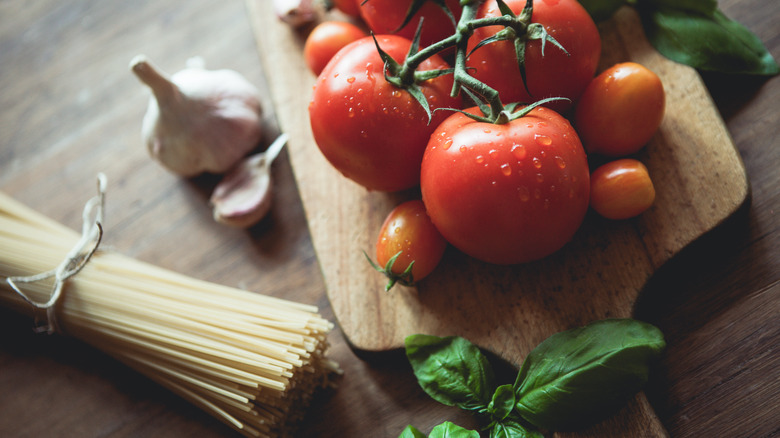Audrey Hepburn's Favorite Meal Was A Simple Italian Classic
The movie-going world knows Audrey Hepburn as the sunglasses- and tiara-wearing heroine of "Breakfast at Tiffany's," to say nothing of the many other romantic classics she helmed in the second half of the 20th century. Others know her for her stint as a goodwill ambassador for UNICEF, which involved advocating for children's rights across the globe. Meanwhile, those close to her knew her as a terrific cook with a yen for Italian cuisine — pasta especially.
In "Audrey at Home: Memories of My Mother's Kitchen," Hepburn's son Luca Dotti recalls one particular dish that had his mom's heart. "If it isn't too complicated, a lovely, simple [spaghetti] al pomodoro with a bit of olive oil would make me so happy," he recalls her saying to restaurant servers when presented with "elaborate and ambitious menus."
Like some of the most beloved Italian dishes, pomodoro favors quality over quantity. A bare-bones version of the sauce, which takes its name from the Italian word for a yellow-tinted tomato, might merely call for tomatoes, good olive oil, garlic, salt, pepper, and basil. Here's how Hepburn put her own spin on it.
Spaghetti al pomodoro favors quality over quantity
When Audrey Hepburn made spaghetti al pomodoro at home — or had it waiting for her after returning from a long trip, as she was wont to request — she used tomatoes from her garden. "[The dish] was a way of saying, 'Here, this is my house, this is how I am, don't expect me to be otherwise,'" wrote Luca.
In addition to vine-ripened tomatoes (which can be subbed for whole-peeled San Marzano canned tomatoes for those who don't have access to quality fresh produce), the recipe in the book takes a nontraditional approach by adding celery, carrot, and onion to the base. The vegetables are cooked with basil and olive oil until thickened and fragrant, passed through a strainer or food mill, and finished with a touch of sugar, another drizzle of olive oil, Parmigiano-Reggiano, and more basil.
Let tomatoes, garlic, and basil run the show for a more classic version of the smooth sauce by leaving out the carrot, onion, celery, and sugar.
Neapolitan origins
Speaking of a classic version of pomodoro, the first recipe for the sauce dates back to the 1837 cookbook "Cucina Teorica-Pratica," written by the Naples-born gastronome and aristocrat Ippolito Cavalcanti. A translation of the recipe, courtesy of The Plant-Based School, says to cook and mash tomatoes, fry a head of garlic in some with lard, and add it to the sauce. Al dente spaghetti is added to the mix, along with salt and pepper. "You'll see what you eat," it reads, suggesting the dish's simplicity inside and out.
While modern versions trade mashing for straining and lard for oil or butter, its essential qualities (a smooth texture and simple yet rich tomato flavor) remain the same. It's no wonder Audrey Hepburn craved it so often. According to Luca Dotti's cookbook contributor, Rochita Orunesu, Hepburn would often cap off a homecoming plate of spaghetti al pomodoro with a bowl of vanilla ice cream.


